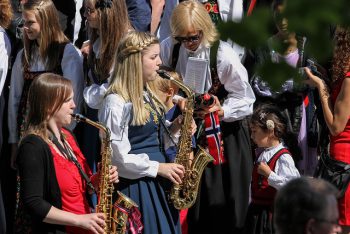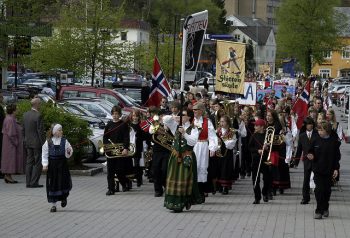17. mai, Step by Step Posted by Bjørn A. Bojesen on May 17, 2018 in Holidays, Traditions
Gratulerer med dagen, Norge! (”Congrats with the day”, Norway!) It’s syttende mai [May 17th] again, and Norwegians all over the world are rejoicing and celebrating their nasjonaldag [nashoNAALdaag]. A 17. mai spent in a Norwegian bygd (village/town) or by (town/city) is a great experience, so for those of you who haven’t got that opportunity, here’s a breakdown of the day…
- 17. mai er en fridag (M17 is a holiday). Most people står opp tidlig (rise early) – especially barna (the children). Everything has to be ready for den store dagen (the big day) – festklær (party clothes), flagg (flags), mat til festmiddagen (food for the party dinner)…
- Most Norwegian girls and women have a bunad [boo-nahd] (national costume), and lots of boys of men have one, too. 17. mai is the day to wear your bunad, so make sure it is clean and presentable! 🙂
- The ceremonies often start quite early – at 7 or 8 o’clock in the morning – with a kransenedleggelse (laying down of wreaths) at a memorial or kirkegård (cemetery). At the Akershus festning (fort) in Oslo, kanoner (canons) are fired as a salute.
- A couple of hours later, it’s time for barnetoget (the children’s parade – sometimes it’s also called skoletoget, the school parade). Children – and some adults, such as teachers – gather to march behind the fane (banner) of their local skole (school) and even barnehage (kindergarten). The tog (parade) has a fixed route through gatene (the streets), so all the proud parents and grandparents get a chance to photograph their marching kids from fortauet (the pavement). On 17. mai, of course, there are no cars on the streets (unless they’re part of a parade).
-
Various korps (marching orchestras) are also following along, playing brass music. Everybody knows the melodies, and sings along. People wave small norske flagg (Norwegian flags) and shout happy things like hurra! Please note that there is only good intentions on May 17th – people celebrate Norway without ”dissing” other countries/cultures. Sometimes, Sami people and immigrants wave their own flags in addition to the Norwegian ones.
- In Oslo, the culmination of barnetoget is when all the children (the internet says 60.000!) march in front of Slottsbalkongen (the Castle Balcony) and are greeted by kongen (the king) and the rest of kongefamilien (the royal family).
- In bigger towns, the children’s parade may be followed by a russetog and a folketog. The russetog is for the russ, 18-or-so-year-olds who’ve finished their ”high school”. They usually wear røde drakter (red suits) and make a lot of fun, like driving in their own russebuss (russ bus) and honking the horn at people.
- Folketoget (the people’s parade) is for just about everybody: policemen, firefighters, hospital employees, sports clubs – every group who wants to ”show its face” to the public.
-
The public celebrations continue for several hours, with 17. mai-taler (May 17th speeches), chatting to friends in the street, public concerts, public leker (outdoor competitions – such as tug of war)… If there’s sol (sun), people eat a lot of is og pølser (ice-cream and sausages).
- Many people end the day by gathering in private for a nice 17. mai-middag (dinner). If the weather’s nice, there’s a good chance your Norwegian friends will invite you to a celebration around hagegrillen (the garden grill).
Hurra for 17. mai!

Build vocabulary, practice pronunciation, and more with Transparent Language Online. Available anytime, anywhere, on any device.






